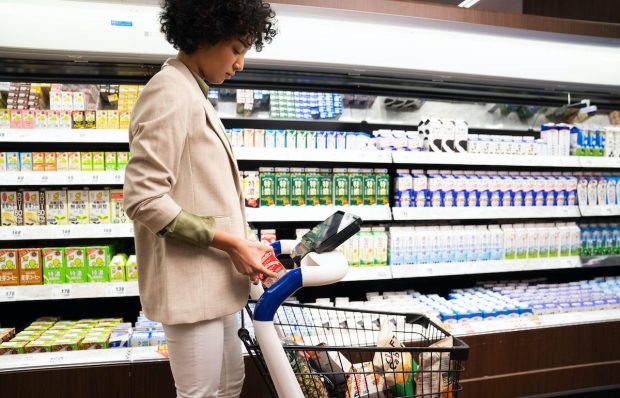Grocers Address Consumers’ Digital Dissatisfaction With Omnichannel Upgrades

Across the grocery industry, merchants are looking for ways to merge digital and brick-and-mortar experiences, especially given that, as PYMNTS research revealed, nearly half of all grocers are dissatisfied with their omnichannel offerings.
At a Digital Food and Beverage Conference keynote presentation Tuesday (June 13), Chad Petersen, senior vice president of eCommerce at Lowes Foods, spoke to grocers, consumer packaged goods (CPG) brands and solution providers about the evolution of omnichannel, and indeed, as recent reports have shown, grocers are bringing more digital capabilities into their physical stores.
For instance, New York City-based grocery chain Morton Williams, which has 16 locations across the city and New Jersey, is gearing up to roll out smart carts. Several months ago, Rochester-based regional supermarket Wegmans began testing out smart carts. In Europe, cashier-less checkout technology provider Sensei announced in March the launch of the continent’s largest-yet autonomous supermarket, nearly 5,400 square feet, dubbed “Dojo” in Lisbon, Portugal. Earlier this year, Instacart announced its first Scan & Pay checkout deployment at Foodcellar Market, a grocer in Queens, New York.
Overall, grocers are indeed looking to integrate digital technologies into the in-store experience. For instance, data from PYMNTS’ study “Big Retail’s Innovation Mandate: Convenience and Personalization,” created in collaboration with ACI Worldwide, which drew from a survey of 300 retailers across the United States and the United Kingdom, revealed that 79% of grocers think consumers would be very or extremely likely to switch merchants if not offered barcode and QR code scanner apps. Plus, 40% said the same about the ability to scan products and pay without standing in line.
Yet, the study noted, 55% of grocers are satisfied with the digital tools that they provide, well behind the 71% of general retailers that said the same, leaving 45% of grocers looking for better solutions.
On the flip side, grocers are looking to bring eCommerce-like data collection capabilities into their brick-and-mortar locations, enabling them to learn about in-store shoppers’ behaviors as well to better sell to those customers going forward. Digital-powered self-checkout technology such as smart carts and scan-and-pay can help offer these insights.
“This is what the next generation of the in-store journey should look like,” Raz Golan, CEO and co-founder of grocery store technology company Shopic, told PYMNTS in an interview. “All these data points are ones that we just couldn’t measure very well until today, and it opens a whole new world of data analytics.”
Overall, consumers have been changed by the shift to eCommerce in recent years, increasingly expecting simple, convenient experiences where once they were willing to put up with the friction of traditional brick-and-mortar shopping.
Findings from PYMNTS’ study “Consumer Inflation Sentiment: The False Appeal of Deal-Chasing Consumers,” for which we surveyed more than 2,100 U.S. consumers in February, revealed that 77% of consumers cited ease/convenience as an important factor that influenced their decision of where to make their most recent grocery purchase.
“You look at a grocery store and just stand in an aisle and watch people shop — the human behavior you see in the store doesn’t look a lot different than it did 10 years ago, or 20 or 50 years ago,” John Ross, president and CEO of the Independent Grocers Alliance (IGA), told PYMNTS in an interview. “That doesn’t mean the shopper is the same, and those shoppers have a digital relationship with most of the brands and services in their lives, and so their expectation of our industry to be able to have a digital connection with them is growing and growing and growing.”

